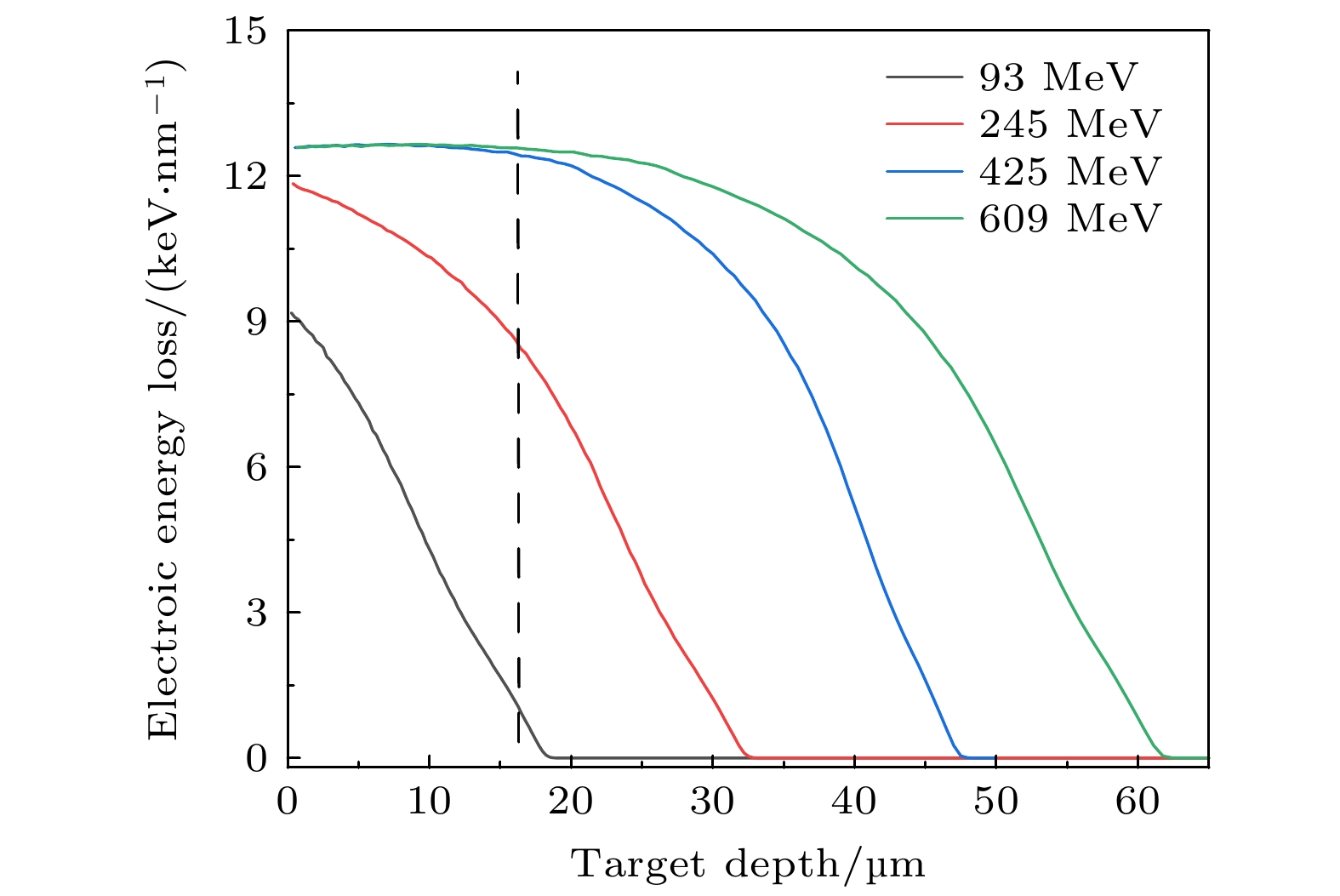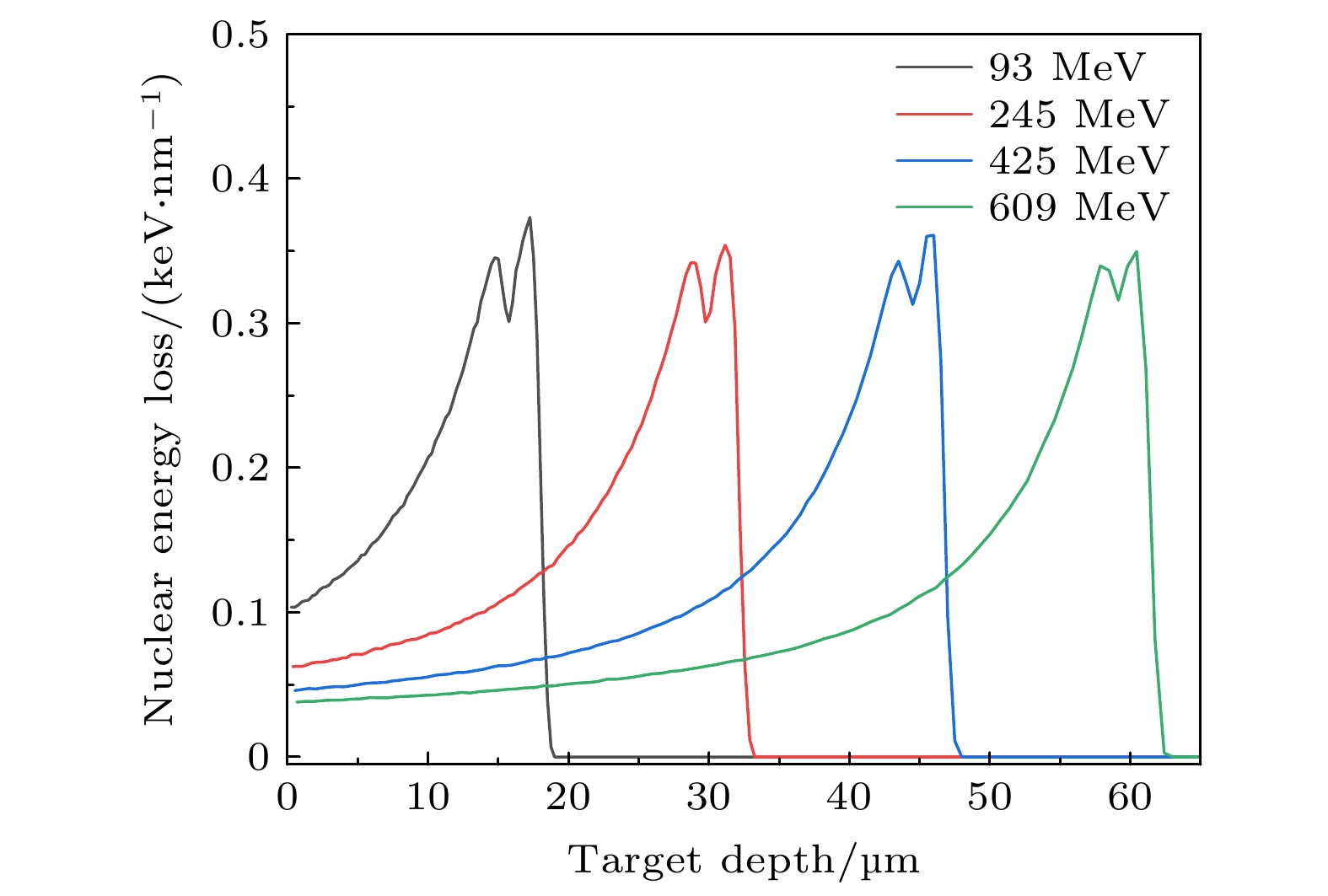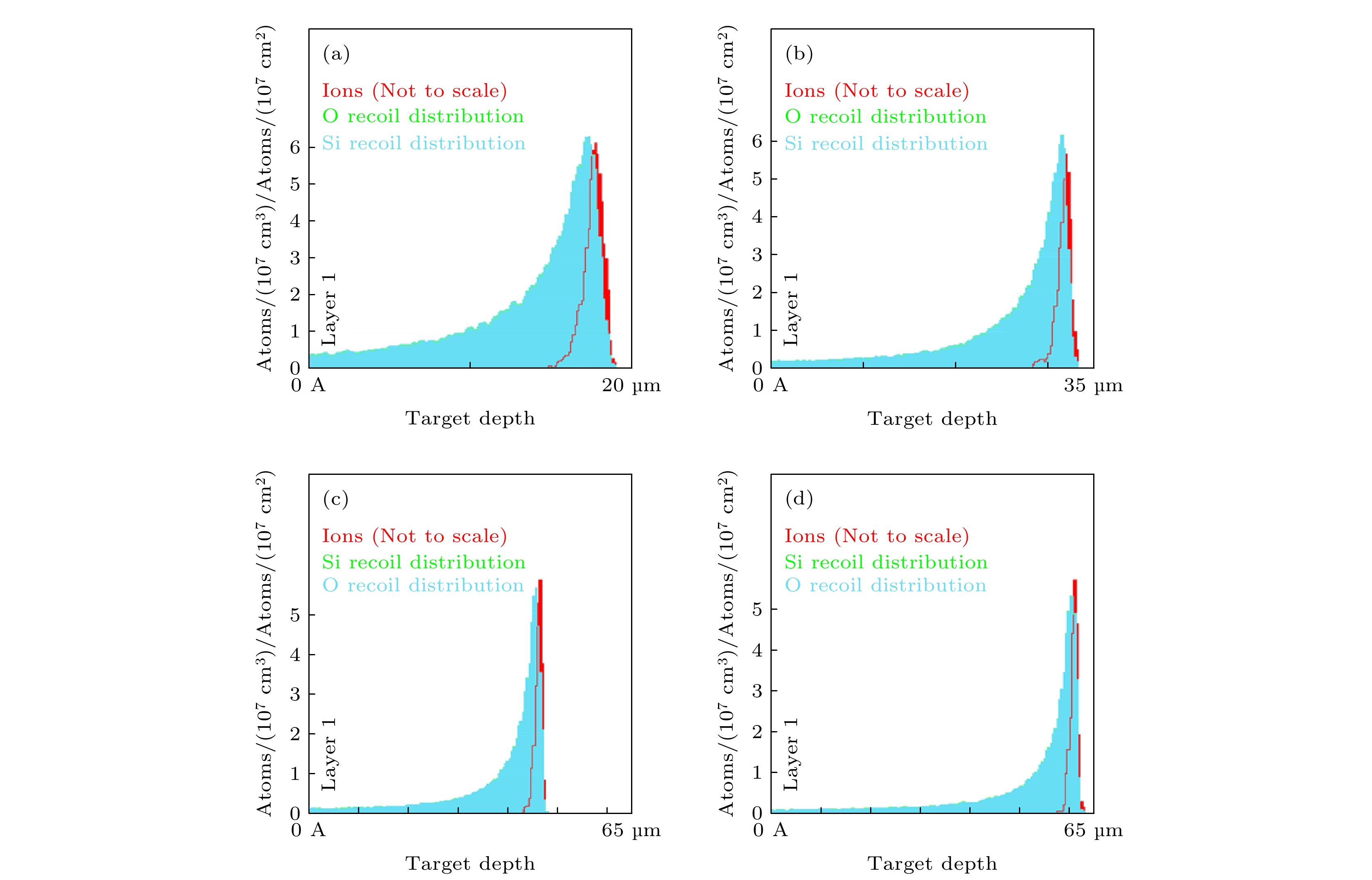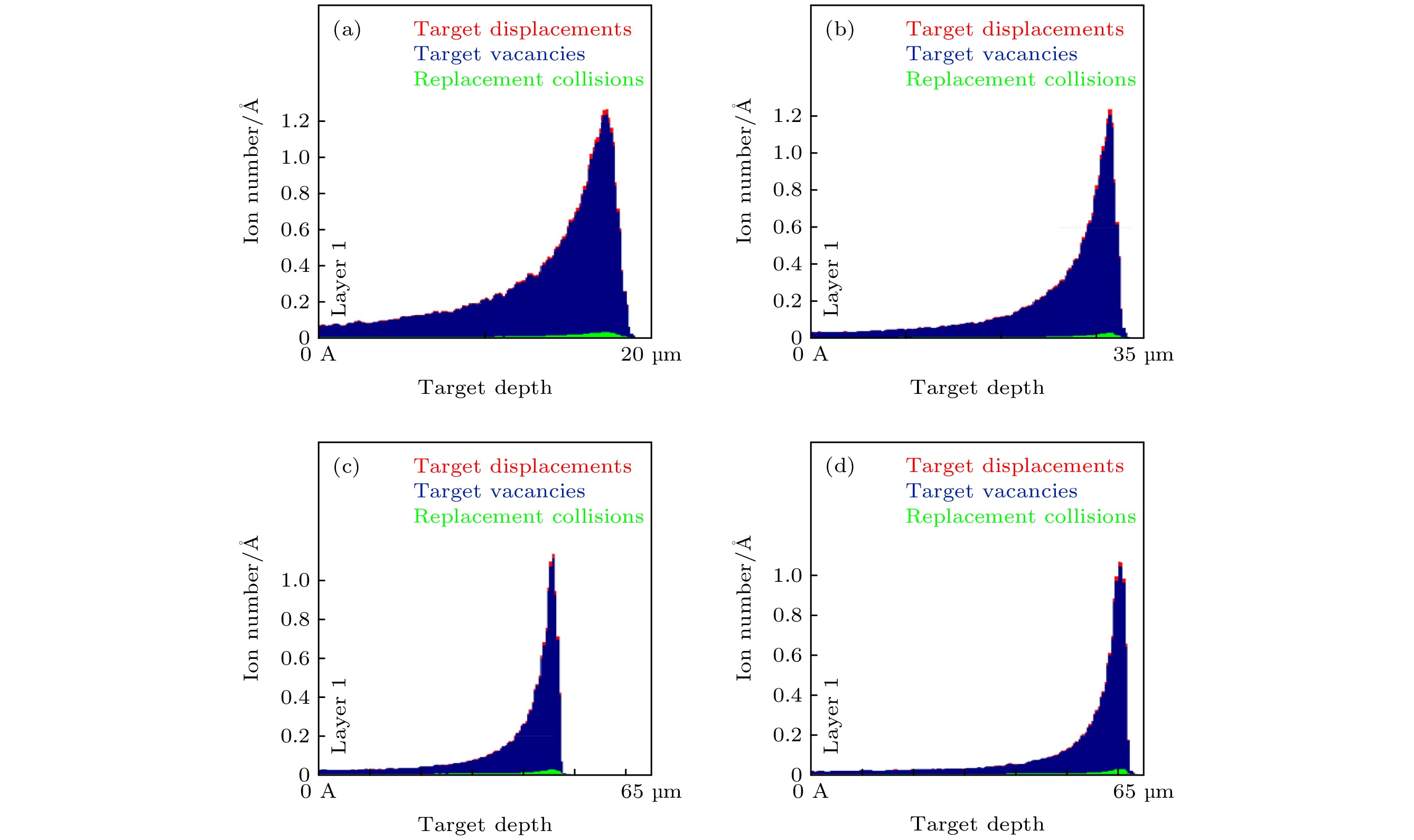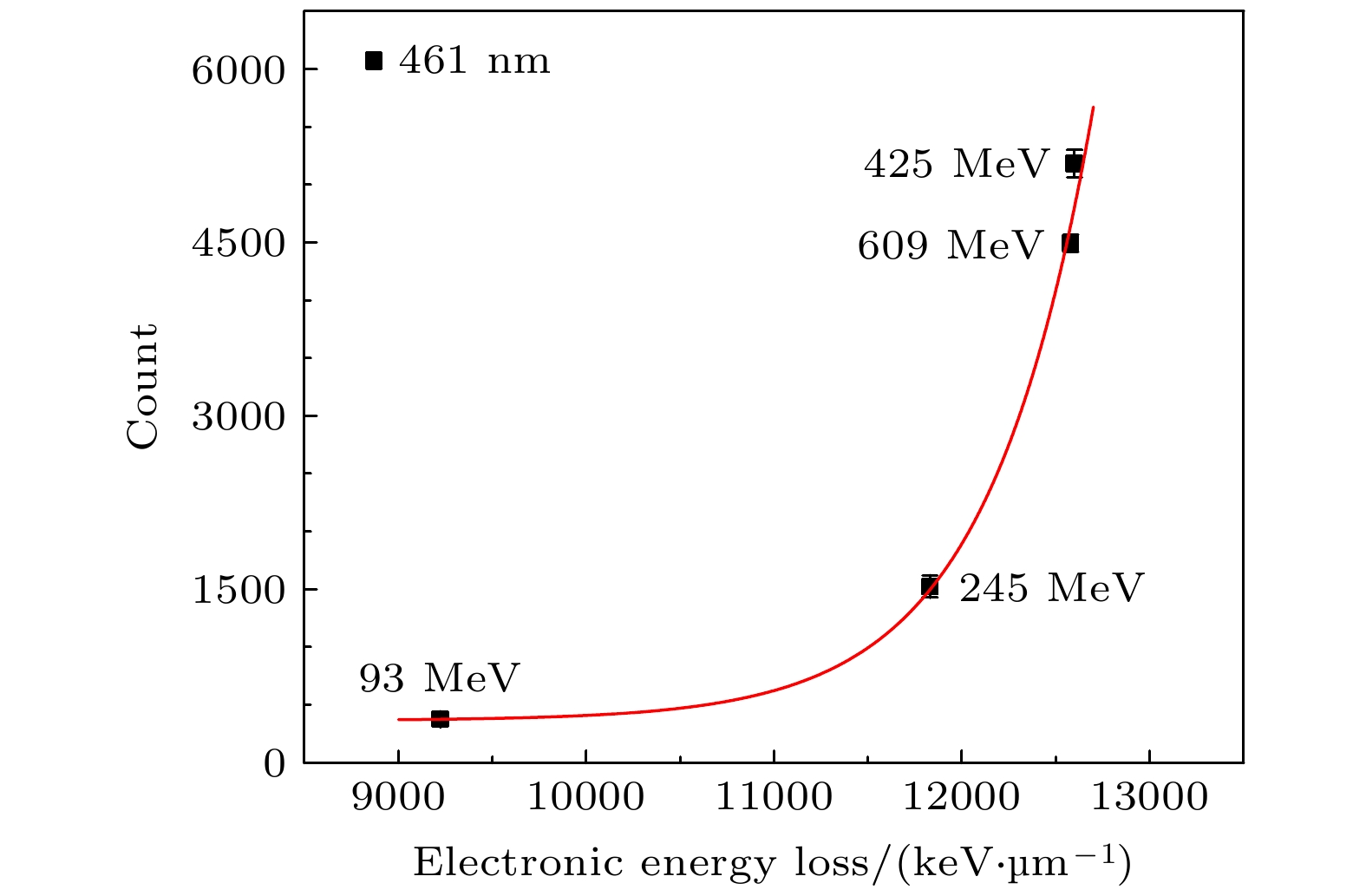-
离子辐照可以改变二氧化硅(SiO2)的晶体结构和光学性质. 采用 645 MeV Xe35+离子辐照SiO2单晶, 在辐照过程中, 利用光栅光谱仪测量在200—800 nm范围内的光发射. 在发射光谱中, 观测到中心位于461和631 nm的发射带. 这些发射带是弗伦克尔激子辐射退激产生的, 其强度与辐照离子能量和辐照离子剂量密切相关. 实验结果表明: 发射光强随离子在固体中的电子能损呈指数增加. 由于离子辐照对晶体造成损伤, 发射光谱强度随辐照剂量的增加而降低. 文中讨论了这些与晶体结构有关的发射带, 结合能量损失机制讨论了激子形成和退激过程. 快重离子辐照过程中发射光谱的原位测量对研究辐照改性具有重要意义, 有助于揭示离子辐照引起晶体损伤的物理机制.Silicon dioxide (SiO2) is an important component of nuclear reactor optical fiber and is also a candidate material for wast solidification. Owing to its special physical and chemical characteristics, it is used in many different technology fields like optics, electronics, energy orspace. Swift heavy ion irradiation can modify the crystal structure and optical property of optical material SiO2. Swift heavy ions deposit their energy mainly by inelastic interaction. Highly ionized lattice atoms may be formed along the trajectory, and a fraction of their electrical energy can be converted directly into the kinetic energy of the ions. The irradiation experiment is performed with Xeq+ ions at the irradiation terminal of the sector-focused cyclotron at heavy-ion research facility in Lanzhou (HIRFL). The on-line spectral measurement experiment is carried out during irradiation. In the darkroom, the UV-visible light emission from the target is focused into optical fiber by a collimating lens, and then is analyzed with the Sp-2558 spectrometer equipped with a 1200 g/mm optical grating blazed at 500 nm. In the present work, SiO2 single crystals are irradiated with 93–609 MeV Xeq+ ions with a dose in a range of 1×1011–3×1011 ions/cm2. During irradiation, the emission spectra, in a range of 200–800 nm, from SiO2 irradiated by 93, 245, 425 and 609 MeV Xeq+ ions, are obtained. Two emission bands centered at 461 and 631 nm are observed. These emission bands are produced by Frenkel exciton radiation de-excitation and their intensities are closely related to the irradiated ion energy and radiation dose. The results show that the light intensity increases with the electron energy loss index increasing. And owing to crystal damage caused by ion irradiation, the intensity of emission spectrum decreases with the augment of irradiation dose. Ion loses its energy throughout the ion track via Sn and Se interacting with target atoms and electrons respectively, and the energy lost by the ion is estimated by using SRIM code. The SRIM simulated ion ranges and recoil atom distribution, target ionization (energy loss to target electrons), damage production in SiO2 are presented. Based on the energy deposition process, the emission bands related to the crystal structure itself are discussed. It indicates that electron energy loss plays a leading role in the process of light emission. In-situ measurement of the optical emission is of great significance in studying the irradiation modification and can help to understand the process of crystal damage caused by ion irradiation.
-
Keywords:
- optical emission band /
- swift heavy ions /
- the electron energy loss /
- silicon dioxide
[1] Yang P, An YL, Yang D Y, Li Y H, Chen J M 2020 Ceram. Int. 46 21367
 Google Scholar
Google Scholar
[2] Li Y H, Wen J, Wang Y Q, Wang Z G, Tang M, Valdez J A, Sickafus K E 2012 Nucl. Instrum. Methods Phys. Res. , Sect. B 287 130
 Google Scholar
Google Scholar
[3] Devine R A B 1994 Nucl. Instrum. Methods Phys. Res. , Sect. B 91 378
 Google Scholar
Google Scholar
[4] Zhu Z, Jung P, Langenscheidt E 1997 J. Non-Cryst. Solids 217 173
 Google Scholar
Google Scholar
[5] Zhu Z Y, Jung P 1994 Nucl. Instrum. Methods Phys. Res. , Sect. B 91 269
 Google Scholar
Google Scholar
[6] Saito K, Ikushima A J 2002 J. Appl. Phys. 91 4886
 Google Scholar
Google Scholar
[7] Wang R P, Tai N, Saitio K, Ikushima A J 2005 J. Appl. Phys. 98 023701
 Google Scholar
Google Scholar
[8] Xue S W, Zu X T, Su H Q, Zheng W G, Xia X, Hong D, Yang C R 2007 Chin. Phys. 16 1119
 Google Scholar
Google Scholar
[9] Imai H, Arai K, Imagawa H, Hosono H, Abe Y 1988 Phys. Rev. B 38 12772
 Google Scholar
Google Scholar
[10] Nishikawa H, Nakamura R, Tohmon R, Ohki Y, Sakurai Y, Nagasawa K, Hama Y 1990 Phys. Rev. B 41 7828
 Google Scholar
Google Scholar
[11] Ziegler J F 2004 Nucl. Instrum. Methods Phys. Res., Sect. B 219 1027
[12] Bettger K (姜东兴, 刘洪涛 译) 1982 重离子物理实验方法 (北京: 原子能出版社) 第149页
Bettger K (translated by Jiang Dongxing, Liu Hongtao) 1982 Experimental Methods in Heavy Ion Physics (Beijing: Atomic Energy Press) p149 (in Chinese)
[13] Stevens-Kalceff M A 2011 J. Phys. D: Appl. Phys. 44 255402
 Google Scholar
Google Scholar
[14] Kaddouri A, Ashraf I, El Fqih M A, Targaoui H, El Boujlaïdi A, Berrada K 2009 Appl. Surf. Sci. 256 116
 Google Scholar
Google Scholar
[15] Song Y, Zhang C H, Yang Y T, Gou J, Zhang L Q, He D Y 2013 Opt. Mater. 35 1057
 Google Scholar
Google Scholar
[16] Patra P, Shah S, Toulemonde M, Sulania I, Singh F 2022 Radiat. Eff. Defects Solids 177 513
 Google Scholar
Google Scholar
[17] Meftah A, Brisard F, Costantini J M, Dooryhee E, Hage-Ali M, Hervieu M, Stoquert J P, Studer F, Toulemonde M 1994 Phys. Rev. B 49 12457
 Google Scholar
Google Scholar
[18] Kluth P, Schnohr C S, Pakarinen O H, Djurabekova F, Sprouster D J, Giulian R, Ridgway M C, Byrne A P, Trautmann C, Cookson D J, Nordlund K, Toulemonde M 2008 Phys. Rev. Lett. 101 175503
 Google Scholar
Google Scholar
[19] Toulemonde M, Weber W J, Li G S, Shutthanandan V, Kluth P, Yang T F, Wang Y G, Zhang Y W 2011 Phys. Rev. B 83 054106
 Google Scholar
Google Scholar
[20] Schwartz K, Trautmann C, El-Said A S, Neumann R, Toulemonde M, Knolle W 2004 Phys. Rev. B 70 184104
 Google Scholar
Google Scholar
[21] Liu C B, Wang Z G 2011 Chin. J. Lumin. 32 608
 Google Scholar
Google Scholar
[22] Udelson B J, Creedon J E, French J C 1957 J. Appl. Phys. 28 717
 Google Scholar
Google Scholar
[23] Liao L S, Bao X M, Zheng X Q, Li N S, Min N B 1996 Chin. J. Semicond. 17 789
-
表 1 不同能量Xeq+离子辐照SiO2植入深度、电子能损和核能损
Table 1. the penetrating depth and, its electronic energy loss and nuclear energy loss of Xeq+ ion in SiO2.
Ion energy
/MeVProjected
range/μmElectronic energy
loss/(×104 keV·μm–1)Nuclear energy loss
/(×10 keV·μm–1)609 60.69 1.258 1.518 425 46.14 1.260 2.063 245 31.59 1.183 3.283 93 17.54 0.9225 7.271 -
[1] Yang P, An YL, Yang D Y, Li Y H, Chen J M 2020 Ceram. Int. 46 21367
 Google Scholar
Google Scholar
[2] Li Y H, Wen J, Wang Y Q, Wang Z G, Tang M, Valdez J A, Sickafus K E 2012 Nucl. Instrum. Methods Phys. Res. , Sect. B 287 130
 Google Scholar
Google Scholar
[3] Devine R A B 1994 Nucl. Instrum. Methods Phys. Res. , Sect. B 91 378
 Google Scholar
Google Scholar
[4] Zhu Z, Jung P, Langenscheidt E 1997 J. Non-Cryst. Solids 217 173
 Google Scholar
Google Scholar
[5] Zhu Z Y, Jung P 1994 Nucl. Instrum. Methods Phys. Res. , Sect. B 91 269
 Google Scholar
Google Scholar
[6] Saito K, Ikushima A J 2002 J. Appl. Phys. 91 4886
 Google Scholar
Google Scholar
[7] Wang R P, Tai N, Saitio K, Ikushima A J 2005 J. Appl. Phys. 98 023701
 Google Scholar
Google Scholar
[8] Xue S W, Zu X T, Su H Q, Zheng W G, Xia X, Hong D, Yang C R 2007 Chin. Phys. 16 1119
 Google Scholar
Google Scholar
[9] Imai H, Arai K, Imagawa H, Hosono H, Abe Y 1988 Phys. Rev. B 38 12772
 Google Scholar
Google Scholar
[10] Nishikawa H, Nakamura R, Tohmon R, Ohki Y, Sakurai Y, Nagasawa K, Hama Y 1990 Phys. Rev. B 41 7828
 Google Scholar
Google Scholar
[11] Ziegler J F 2004 Nucl. Instrum. Methods Phys. Res., Sect. B 219 1027
[12] Bettger K (姜东兴, 刘洪涛 译) 1982 重离子物理实验方法 (北京: 原子能出版社) 第149页
Bettger K (translated by Jiang Dongxing, Liu Hongtao) 1982 Experimental Methods in Heavy Ion Physics (Beijing: Atomic Energy Press) p149 (in Chinese)
[13] Stevens-Kalceff M A 2011 J. Phys. D: Appl. Phys. 44 255402
 Google Scholar
Google Scholar
[14] Kaddouri A, Ashraf I, El Fqih M A, Targaoui H, El Boujlaïdi A, Berrada K 2009 Appl. Surf. Sci. 256 116
 Google Scholar
Google Scholar
[15] Song Y, Zhang C H, Yang Y T, Gou J, Zhang L Q, He D Y 2013 Opt. Mater. 35 1057
 Google Scholar
Google Scholar
[16] Patra P, Shah S, Toulemonde M, Sulania I, Singh F 2022 Radiat. Eff. Defects Solids 177 513
 Google Scholar
Google Scholar
[17] Meftah A, Brisard F, Costantini J M, Dooryhee E, Hage-Ali M, Hervieu M, Stoquert J P, Studer F, Toulemonde M 1994 Phys. Rev. B 49 12457
 Google Scholar
Google Scholar
[18] Kluth P, Schnohr C S, Pakarinen O H, Djurabekova F, Sprouster D J, Giulian R, Ridgway M C, Byrne A P, Trautmann C, Cookson D J, Nordlund K, Toulemonde M 2008 Phys. Rev. Lett. 101 175503
 Google Scholar
Google Scholar
[19] Toulemonde M, Weber W J, Li G S, Shutthanandan V, Kluth P, Yang T F, Wang Y G, Zhang Y W 2011 Phys. Rev. B 83 054106
 Google Scholar
Google Scholar
[20] Schwartz K, Trautmann C, El-Said A S, Neumann R, Toulemonde M, Knolle W 2004 Phys. Rev. B 70 184104
 Google Scholar
Google Scholar
[21] Liu C B, Wang Z G 2011 Chin. J. Lumin. 32 608
 Google Scholar
Google Scholar
[22] Udelson B J, Creedon J E, French J C 1957 J. Appl. Phys. 28 717
 Google Scholar
Google Scholar
[23] Liao L S, Bao X M, Zheng X Q, Li N S, Min N B 1996 Chin. J. Semicond. 17 789
计量
- 文章访问数: 7003
- PDF下载量: 71
- 被引次数: 0














 下载:
下载:



